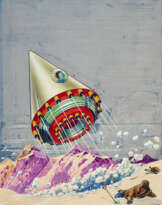ID 1353370
Lot 42 | New York Destroyed by Monstrous Solar Ray
Estimate value
£ 3 000 – 5 000
New York Destroyed by Monstrous Solar Ray
signed PAUL (lower left)
ink and paint on paper
163/4 x 123/4 in. (42.6 x 32.4 cm.) (sight)
Executed circa 1934.
A fine artwork for Wonder Stories by the 'father of science fiction illustration art'.
Frank R. Paul established many of the visual traditions in the science fiction genre. His pioneering imagery adorned magazine covers and provided rich visual accompaniment to the stories that filled their pages. The present illustration was published in the September 1934 issue of Wonder Stories alongside the story Enslaved Brains, written by Eando Binder, a pseudonym used by brothers Earl and Otto Binder. Enslaved Brains is set in an authoritarian dystopia where scientists control society through eugenics laws and reanimate the brains of the dead to operate machinery. Paul's depiction of the solar ray capable of destroying major cities perhaps owes something to the contemporary claims by figures such as Nikola Tesla and Guglielmo Marconi to have invented a powerful 'death beam'.
Paul was born in Austria and trained as an architect in Vienna before emigrating to New Jersey before World War I. He was hired by Hugo Gernsback in 1914 to illustrate the science magazine The Electrical Experimenter. Amongst his many publications, Gernsback published Amazing Stories which is known as the first science fiction magazine which established the genre in 1926. Paul created hundreds of cover illustrations for Amazing Stories, Wonder Stories and several other pulp magazines. His most famous cover was published for the August 1927 edition of Amazing Stories, illustrating H.G. Wells’s The War of the Worlds. Paul’s lasting influence on the visual vocabulary of science fiction can be found in the representation of aliens, machines, spaceships and especially the architecture of 'other worlds'.
| Address of auction |
CHRISTIE'S 8 King Street, St. James's SW1Y 6QT London United Kingdom | |
|---|---|---|
| Preview |
| |
| Phone | +44 (0)20 7839 9060 | |
| Buyer Premium | see on Website | |
| Conditions of purchase | Conditions of purchase |









